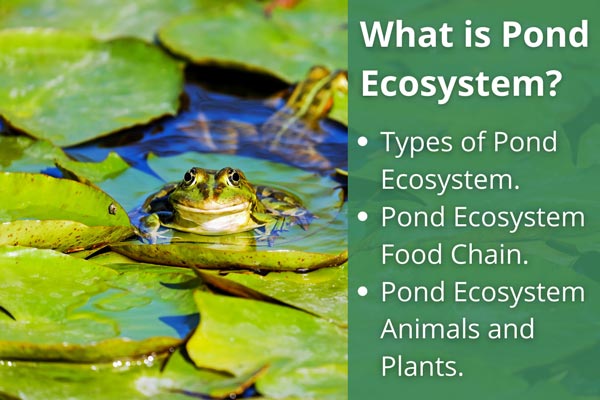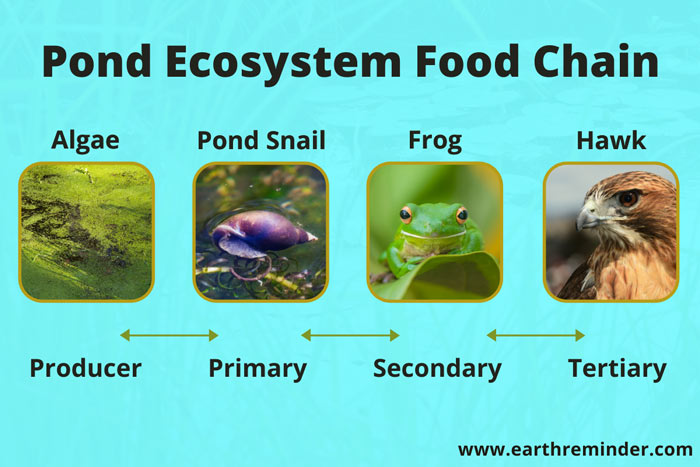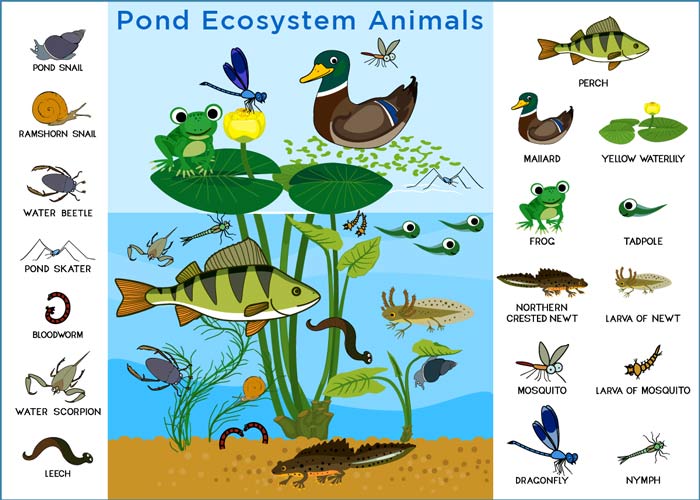What Plants Or Animals Are The Primary Producers In This Food Chain
Table of Contents
- ane What Is Pond Ecosystem?
- 2 Types of Pond Ecosystem
- 2.ane Garden ponds
- 2.ii Common salt Ponds
- two.3 Fish Ponds
- two.4 Vernal or Imperceptible Ponds
- 2.5 Freshwater Ponds
- 2.6 Kettle Ponds
- 2.vii Mountain Ponds
- 3 Characteristics of Swimming Ecosystem
- 4 Pond Ecosystem Food Chain
- 4.1 Producer Level
- 4.2 Main Consumers
- iv.three Secondary Consumers
- 4.4 Third Consumers
- four.5 Decomposers
- five Pond Ecosystem Animals
- 6 Pond Ecosystem Plants
- 6.1 Categories of Aquatic Plants
- 6.2 Aquatic Plants Benefits
What Is Pond Ecosystem?
Freshwater habitat: A pond ecosystem is a freshwater ecosystem on which different living organisms depend for their survival and nutritional needs. Ponds, due to their light penetration, are capable of supporting a diverse range of water plants.

An ecosystem is a biological community of living organisms that live and interact with each other in a specific surround.
Lentic Ecosystem: The pond ecosystem is classified under the Lentic ecosystem. A lentic or lacustrine ecosystem implies a body of yet water ranging from seeps, seasonal pools, ponds, basin marshes, ditches, swamps, and lakes.
Simply, we can define a pond ecosystem as – "Pond ecosystem is a freshwater ecosystem on which living organisms rely for their survival and food. Ponds are shallow water bodies going about 12–xv feet deep. Due to enough light penetration, ponds tin can facilitate plant growth."
Types of Pond Ecosystem
At that place are many types of pond ecosystems, i.e. garden ponds, common salt ponds, fish ponds, ephemeral ponds, freshwater ponds, kettle ponds, and mountain ponds.
Garden ponds
Garden ponds are human-made or bogus ponds. They accommodate ornamental plant and animal species (backswimmers, water beetles, pond snails, and then on) from all over the world. Near garden ponds are usually closed ecosystems. They receive materials from exterior such as rainfall, leaves and export unlike creatures at larvae stages.
Table salt Ponds
Salt ponds conduct salty or brackish h2o. It can appear most the seaside where due to waterlogging, natural pools grade. Salt ponds can also materialize in rocky areas of the beach, also known as stone pools.
Fish Ponds
Information technology is another blazon of pond ecosystem. Fish ponds are man-fabricated or artificial ponds. They can maintain and host all species of fish. Fish ponds crave high maintenance, including continuous ph. level and temperature check, monitor absorbed oxygen content, h2o hardness, and nutrient levels.
Vernal or Ephemeral Ponds
Vernal pools are cyclical, seasonal ponds. They are formed in depressions in the ground simply just when the rainfall is at its heaviest. Although they stay just for few months, they are largely depended on by species like salamanders, water crowfoot, frogs, and many more. Birds employ them for drinking water and hunting nutrient.
Freshwater Ponds
Freshwater pools tin exist formed anywhere, either due to rainfall or past the presence of water saturating the soil. They can exist formed by rivers flowing into a depression in the ground.
Kettle Ponds
Kettle ponds are formed when retreating glaciers create depressions in the basis. A part of the glacier, when it detaches and gets inserted into the ground, slowly melts away and forms a puddle or a pond that constitutes glacial sediment. They are usually found near mountains like prairies and savanna.
Mountain Ponds
Mountain ponds are located in mountainous regions. They are formed by shifting stone, water runoff, and melting snow. They are a unique swimming ecosystem, for they are home to rare or endangered species.
Characteristics of Pond Ecosystem
Many things separate pond ecosystems from other types of ecosystems. Hither is a listing of some main characteristics of pond ecosystems: —
- Pond habitats at different levels—At theswimming bottom, there is very picayune oxygen; hence simply decomposers and scavengers live there. Fish dominates and preys inpond mid-water. On thepond surface, there is enough of light and oxygen. Ducks, tadpoles, midge larvae survive here. At thepond margin, plants provide shelter to small-scale animals and insects.
- Withal water—Still water pond ecosystem is a body of motionless or standing water. It is categorized under the lentic ecosystem, which includes lakes and wetlands every bit well. In comparison, a lotic ecosystem is a body of moving water such as rivers and streams.
- Biological organization—Ponds accept both biotic and abiotic components. Biotic components include environmental factors such every bit temperature, water, and light, inorganic components such as nitrogen, carbon dioxide, and oxygen, organic components such as fats, proteins, carbohydrates, and amino acids. Abiotic components contain producers, primary, secondary and tertiary consumers, and decomposers.
- Surrounded by banks—Pond ecosystems are almost ever surrounded by either natural or artificial banks.
- Swimming stratification—At that place are three zones. The littoral zone is nigh the shore and has shallow water, which allows easy light penetration. Limnetic zone is open pond water with high low-cal penetration dominated by plankton. The deepest pond region is a profundal zone dominated by heterotrophs and has no light penetration.
- Size variation—Pond ecosystems vary in size; it ranges from very pocket-size such every bit stone pools to very large such as lakes.
Pond Ecosystem Nutrient Chain
The menstruation of energy:For an ecosystem to work, there must be a menses of free energy within it. Living organisms require energy in the course of food. Notwithstanding, the supreme source of energy is the lord's day.
Food chain:A nutrient concatenation is a series in which each organism feeds on the ane below it.

Habitat:All ponds support a wide multifariousness of plant and animal life that unitedly forms a food spider web, which is also called a food chain or an ecosystem. The nutrient web explains how life's energy moves through the Pond. An untidy pond by and large supports virtually species.
Below is the caption of the food chain of pond ecosystem:
Producer Level
The producer level includes species of rooted and floating (algae) aquatic plant life that intakes sunlight, air, water, and minerals of the soil. The aquatic life converts these absorbed units into living or sentient establish tissue that further supports every level of the Pond'south food spider web. There are ii types of light-green aquatic plants- microphytes (Volvox and Spirogyra) and macrophytes.
Primary Consumers
The primary consumers consist of small-scale herbivorous animals that feed on food converted past producers such as algae and also feed on other water plants to sustain themselves. These animals are snails, insects, tadpoles, and small fish. They as well include various microscopic animals that are called zooplankton.
Secondary Consumers
The second level in the swimming food web makes upward secondary consumers who feed on the main consumers. The animals in the 2nd level are frogs, fish, crayfish, other amphibians, and reptiles like h2o snakes and turtles.
3rd Consumers
Tertiary consumers eat primary and secondary level animals. The 3rd level consumer includes water birds, hawks, pocket-sized mammals, and human beings. However, human being beings are classified as top consumers.
Decomposers
Bacteria, scavengers, and fungi are the last consumers of the Pond's nutrient web. They intermission down decaying and dead aquatic plants and animals. The recycling of elemental nutrients by decomposers makes bachelor the nutrients to new generations of plants.
Pond Ecosystem Animals
Big pond species:More than than a chiliad genera of animals live in ponds, although you won't be able to find all of them in any 1 single pond. In a very large pond, y'all might find mammals like water shrews and water voles and birds such as herons, ducks, and kingfishers.
Pocket-sized pond species:Fifty-fifty the smallest Pond will have a populace of amphibians such as newts, toads, frogs and, small fish like sticklebacks, and invertebrates like minibeasts.
Other Species:Some species are herbivores similar water fleas and snails, while others are fierce carnivores who hunt the unfortunate herbivores. I of the mighty invertebrate predators in a pond is the diving beetle. No tadpole is safe when this hunter is effectually.

Temperature:The water temperature, water cleanliness, oxygen content, and the material at the bottom of the pond influence the kind of life present in a pond.
Swimming ecosystem animals with examples are mentioned below:
- Swimming Snail— A soft-bodied animal with a hard, protective shell. They eat rotten organic affair, algae, and aquatic plants.
- Ramshorn Snail—Freshwater snails with planispiral shells. They keep the water clean.
- Water Beetle—Water beetles provide air supply due to the elytra cavity underneath their abdomens. H2o beetle tin can be scavengers, predators, or herbivores.
- Swimming skater—Are as well called water scooters, h2o striders, h2o skippers. A bug that walks on water.
- Bloodworm—Bloodworms are carnivorous and tin can abound upwardly to 35 cm. They are commonly constitute at the bottom of shallow waters.
- Water Scorpion— Information technology is some other type of brute in swimming ecosystem. A venomous arachnid with a large stinger on its tail. They are poor swimmers, and that is why they are never found in open up h2o. They live in muddy ponds and ditches.
- Leech—Leech has muscular, soft, and segmented bodies that tin lengthen and contract. Leeches are found in freshwater besides every bit on land. They are bloodsuckers only also consume organic droppings.
- Perch— A perch is long and rounded. True perch has rough scales. Ruby-red pulsate is a saltwater dweller and is chosen red perch.
- Mallard— The mallard is a common wild duck that is the ancestor of most domestic ducks. Mallard feeds on plants as well as pocket-size animals in swimming shallows.
- Frog—Tadpoles grow up to be frogs. Frogs have moist, smooth skin. Frogs eat worms, insects, rodents, anthropods.
- Tadpole—Tadpoles are the aquatic larva of amphibians. They breathe through gills. Tadpoles are more often than not vegetarians, but some species of frogs are carnivorous.
- Northern crested newt— It is a large newt. Females abound up to 6.3 inches long. Too known as warty newt or great crested newt. Northern crested newt more often than not lives on land but movement to fish-complimentary ponds to breed in spring.
- Newt- Newts are small, brightly-colored salamanders and have rough skin. They lay eggs in water.
- Mosquito— A small-scale flying insect that is a carrier of the disease. Female insects lay eggs on the pond surface that hatch into larvae. These larvae consume organic debris and algae.
- Larva of Mosquito—Mosquito larvae are chosen wrigglers because of their wriggling motion. Mosquito larvae eat algae, other mosquitos, and organic debris.
- Dragonfly— The dragonfly is an insect that flies and has a long abdomen. Dragonfly is likewise called devil's arrow. They swallow small insects. Young dragonflies are called nymphs or larvae.
- Nymph—Nymph is an invertebrate. Nymphs endure multiple development stages called instars. The water nymphs accept gills. They bladder and crawl out of the water when they reach maturity.
Pond Ecosystem Plants
Aquatic plants provide shelter, food, and a salubrious environment for fish in ponds. Aquatic plants are vital to maintaining a balanced ecosystem. Forming the food chain base of operations, they produce oxygen in the water and protect invertebrates and small fish. The aquatic plant's roots prevent soil erosion by holding the soil in identify in the Swimming.
Categories of Aquatic Plants
-
- Algae:Algae is the nigh common aquatic plant. They are generally found in oceans. They are small and have no leaves, roots, or stems. But they are an of import basis of the pond food concatenation. Musk grass and lyngbya are examples of algae.
- Submersed plants: Aquatic plants that live underwater and have roots in the soil, such as bog moss, bladderwort, hydrilla, and pondweed. These plants have narrow and thin leaves.
- Floating leaved plants: Aquatic plants floating about or at the h2o surface either are rooted in the soil similar lily pads and duckweed or accept floating roots. They exist in freshwater and saltwater. The floating plant leaves are flat and business firm, which helps blot a lot of sunlight.
- Shoreline: Aquatic plants prefer to stay on the shore but can tolerate being moist and flooded seasonally like trees, shrubs, and blue flag iris.
- Emerged plants: Emergent or emerged or emersed aquatic plants take strong roots in the soil, only their larger part stays higher up the water surface, such as knotweed, cattails, redroot, arrowheads, and rushes. These plants require constant sunlight.
Aquatic Plants Benefits
- Comeback of water quality: Some water plants soak upwards pollutants and heavy metals, which assist in improving h2o quality. Aquatic plants as well remove backlog nutrients that assistance forestall contaminants enter the Swimming. The shoreline plants absorb nitrogen and phosphorus before algae could use them.
- Habitat for wildlife: Aquatic plants provide a layout for fish to hide to protect them from predators. Some construct a nesting site in vegetation. But some fish use plants to catch their casualty. Plants also provide shade which helps reduce the amount of sunlight entering the water, thus helping to slow downwardly algae growth.
- Algae control: Aquatic plants that absorb nutrients such as fish waste help to reduce nutrient availability, thus slowing downwardly algae growth. Floating plants like water lettuce, water hyacinth are heavy feeders. They assistance in starving algae and forestall the Pond from going green.
- Stabilized shorelines: Shoreline or emerging plants have large root structures. This helps to reduce wave flow and stabilize the shore. They agree on to the sediments at the pond bottom effectively.
- Nutrient for fish and wildlife: Toads, fish, turtles, insects, ducks, and many other animals in the Pond consumes aquatic plants.
- Better Aesthetics:Aquatic plants add beauty to the Pond with colorful flowers floating on the surface while maintaining a healthy and balanced swimming ecosystem.
- Native plants including grass, rush, reed, iris, lily pads, arrowhead, pickerel plants, shoreline shrubs, and copse are some of the options to choose from to manage the natural Pond.
- Plants in pond ecosystem: All ponds support aquatic plants at various depths of water. Even so, the native plant species differ by location in the world. Evergreen plants that are intolerant of winter frosts typically abound in tropical regions, while in moderate climates, plants that go passive in wintertime resprout from their roots.
Pond ecosystem is significant in providing a place of dwelling to the endangered species and ensures more than biodiversity than freshwater. Ponds also provide vegetation and h2o to animals during hot weather. Ponds are essential for nature. They should be conserved and preserved.
Source: https://www.earthreminder.com/pond-ecosystem-types-food-chain-animals-plants/
Posted by: jacobssquill1950.blogspot.com

0 Response to "What Plants Or Animals Are The Primary Producers In This Food Chain"
Post a Comment